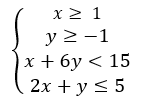Here are the essential concepts you must grasp in order to answer the question correctly.
Inequalities
Inequalities are mathematical expressions that show the relationship between two values when they are not equal. They can be strict (using < or >) or non-strict (using ≤ or ≥). Understanding how to interpret and graph inequalities is crucial for visualizing solution sets in a coordinate plane.
Recommended video:
Graphing Systems of Inequalities
Graphing systems of inequalities involves plotting each inequality on a coordinate plane and identifying the region where all inequalities overlap. This region represents the solution set. The boundaries of the inequalities are often represented as solid lines (for ≤ or ≥) or dashed lines (for < or >) to indicate whether points on the line are included in the solution.
Recommended video:
Feasibility of Solutions
The feasibility of solutions refers to whether a system of inequalities has at least one solution. If the regions defined by the inequalities do not overlap, the system has no solution. Analyzing the constraints imposed by each inequality helps determine if a feasible region exists.
Recommended video:
Categorizing Linear Equations

 Verified step by step guidance
Verified step by step guidance Verified video answer for a similar problem:
Verified video answer for a similar problem:

